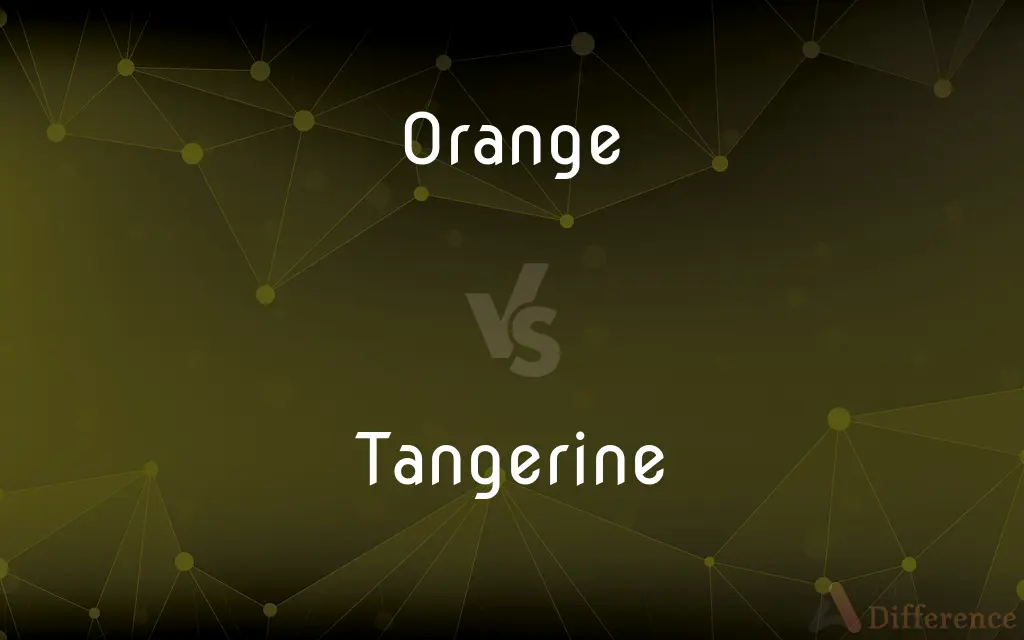Orange vs. Tangerine — What's the Difference?
By Tayyaba Rehman & Maham Liaqat — Updated on March 24, 2024
Oranges are generally larger and have a thicker skin, while tangerines are smaller, sweeter, and easier to peel.

Difference Between Orange and Tangerine
Table of Contents
ADVERTISEMENT
Key Differences
Oranges, known for their bright color and slightly bitter taste, are a popular fruit worldwide, serving as a rich source of vitamin C and fibers. Whereas tangerines, a variant within the orange family, are smaller, sweeter, and characterized by their loose skin, making them easier to peel and segment. This ease of peeling and the sweet flavor make tangerines particularly popular as a snack or in desserts.
While oranges are often used in a variety of culinary applications, from juices and smoothies to marinades and desserts, their thicker skin and sometimes bitter undertones can limit their use in certain dishes. On the other hand, tangerines, with their sweeter profile and less pith, are more frequently consumed fresh or used in salads, desserts, and confections, offering a different range of culinary possibilities.
Oranges provide a significant amount of vitamin C, along with potassium, calcium, and vitamin A, making them a nutritious addition to the diet. Tangerines, although also rich in vitamin C and A, have slightly different nutritional profiles, often containing more vitamin A and less vitamin C per serving compared to oranges, which may influence their impact on health.
The cultivation of oranges has a long history, with diverse varieties grown in different climates around the world. Tangerines, while also widely cultivated, have a shorter history of cultivation and tend to be more sensitive to cold weather, limiting their production to more temperate regions.
In terms of commercial production and availability, oranges are among the most produced fruits globally, leading to a year-round availability in many parts of the world. Tangerines, while also widely available, have a more seasonal presence in markets, with peak seasons varying by region, thus affecting their accessibility and price.
ADVERTISEMENT
Comparison Chart
Size
Larger
Smaller
Skin Thickness
Thicker skin, harder to peel
Thinner skin, easier to peel
Taste
Slightly bitter, not as sweet
Sweeter
Nutritional Value
Rich in vitamin C, potassium, calcium
Higher in vitamin A, slightly less vitamin C
Usage
Juices, smoothies, cooking
Eaten fresh, desserts, salads
Compare with Definitions
Orange
A citrus fruit known for its slightly bitter flavor and high vitamin C content.
Oranges are often squeezed for fresh juice.
Tangerine
Seasonally available, with peak seasons varying.
Tangerines are especially popular during winter months.
Orange
Used in a wide range of culinary dishes, from savory to sweet.
Orange zest adds a vibrant flavor to baked goods.
Tangerine
A type of mandarin orange, noted for its sweetness and easy-to-peel skin.
Tangerines make a convenient snack due to their easy peeling.
Orange
Cultivated worldwide in tropical and subtropical climates.
Brazil is one of the largest producers of oranges.
Tangerine
Smaller and more delicate than most oranges.
Tangerines fit easily in the palm of a hand.
Orange
Typically larger with a thick and often rough skin.
Peeling an orange can be challenging due to its thick skin.
Tangerine
More sensitive to cold, limiting their cultivation to milder climates.
Tangerines are often grown in Mediterranean regions.
Orange
Available year-round due to extensive cultivation.
Oranges are a staple in fruit markets globally.
Tangerine
Preferred for fresh consumption or in light desserts.
Tangerine segments are a popular addition to fruit salads.
Orange
A town in southern France, on the River Rhône, home of the ancestors of the Dutch royal house.
Tangerine
The tangerine is a type of orange. Its scientific name varies.
Orange
Relating to the Orange Order
Orange marches
Tangerine
A widely cultivated variety of mandarin orange having deep red-orange fruit with easily separated segments.
Orange
Any of several evergreen trees of the genus Citrus of Southeast Asia, widely cultivated in warm regions and having fragrant white flowers and round fruit with a yellowish or reddish rind and a sectioned, pulpy interior, especially the sweet orange and the bitter orange.
Tangerine
A strong reddish orange to strong or vivid orange.
Orange
The fruit of any of these trees, having a sweetish, acidic juice.
Tangerine
Any of several varieties of mandarin oranges.
Orange
Any of several similar plants, such as the Osage orange and the mock orange.
Tangerine
A deep yellowish-orange colour, like that of a tangerine fruit.
Orange
The hue of that portion of the visible spectrum lying between red and yellow, evoked in the human observer by radiant energy with wavelengths of approximately 590 to 630 nanometers; any of a group of colors between red and yellow in hue, of medium lightness and moderate saturation.
Tangerine
A tree that produces tangerines.
Mandarin orange
Orange
Of the color orange.
Tangerine
Of a deep yellowish-orange colour.
Orange
Made from oranges.
Tangerine
A kind of orange, much like the mandarin, but of deeper color and higher flavor. It is said to have been produced in America from the mandarin.
Orange
Tasting or smelling like oranges.
Tangerine
A variety of mandarin orange
Orange
(countable) An evergreen tree of the genus Citrus such as Citrus sinensis.
Tangerine
Any of various deep orange mandarins grown in the United States and southern Africa
Orange
(countable) The fruit of the orange tree; a citrus fruit with a slightly sour flavour.
Tangerine
A reddish to vivid orange color
Orange
The colour of a ripe fruit of an orange tree, midway between red and yellow.
Tangerine
Of a strong reddish orange color
Orange
Various drinks:
Orange
(uncountable) Orange juice.
Orange
(uncountable) An orange-coloured and orange-flavoured cordial.
Orange
(uncountable) An orange-coloured and orange-flavoured soft drink.
Orange
Having the colour of the fruit of an orange tree; yellowred; reddish-yellow.
Orange
(transitive) To color orange.
Orange
(intransitive) To become orange.
Orange
The fruit of a tree of the genus Citrus (Citrus Aurantium). It is usually round, and consists of pulpy carpels, commonly ten in number, inclosed in a leathery rind, which is easily separable, and is reddish yellow when ripe.
Orange
The tree that bears oranges; the orange tree.
Orange
The color of an orange; reddish yellow.
Orange
Of or pertaining to an orange; of the color of an orange; reddish yellow; as, an orange ribbon.
Orange
Round yellow to orange fruit of any of several citrus trees
Orange
Any of a range of colors between red and yellow
Orange
Any citrus tree bearing oranges
Orange
Any pigment producing the orange color
Orange
A river in South Africa that flows generally westward to the Atlantic Ocean
Orange
Similar to the color of a ripe orange
Common Curiosities
Are tangerines and oranges grown in the same conditions?
No, oranges tolerate a wider range of climates, while tangerines prefer milder conditions.
Which is healthier, an orange or a tangerine?
Both are healthy; oranges have more vitamin C, while tangerines have more vitamin A.
Why are tangerines easier to peel than oranges?
Tangerines have thinner skin and looser pith, making them easier to peel.
How do the nutritional benefits of oranges and tangerines compare?
Both offer nutritional benefits, but oranges are higher in vitamin C and tangerines in vitamin A.
What's the primary taste difference between an orange and a tangerine?
Oranges are slightly bitter and not as sweet, while tangerines are sweeter.
Why are oranges used more frequently in juices than tangerines?
Oranges are less sweet, more abundant, and yield more juice, making them ideal for juicing.
Is there a significant difference in the way oranges and tangerines are harvested?
The basic methods are similar, but tangerines may require more delicate handling due to their thinner skins.
How does the seasonal availability of oranges and tangerines affect their market price?
Oranges are generally cheaper due to year-round availability, while tangerines can be pricier during off-seasons.
Can you eat the skin of tangerines like you can with some oranges?
Generally, citrus skins are not eaten, though tangerine zest can be used in cooking.
Can you substitute tangerines for oranges in recipes?
Yes, but expect a sweeter taste and less acidity in the dish.
Are there any cooking applications where tangerines are preferred over oranges?
Yes, in desserts and salads where a sweeter, more delicate flavor is desired.
What's a quick snack option using tangerines?
Eating them fresh or in fruit salads are popular options.
Are seedless varieties available for both oranges and tangerines?
Yes, seedless varieties are available for both, offering more convenience.
Do oranges and tangerines have the same storage life?
Generally, oranges have a longer shelf life due to their thicker skin.
What are the main types of dishes that use oranges?
From savory dishes and salads to desserts and drinks, oranges are versatile in cooking.
Share Your Discovery

Previous Comparison
Ivory vs. Ecru
Next Comparison
Scotland vs. IrelandAuthor Spotlight
Written by
Tayyaba RehmanTayyaba Rehman is a distinguished writer, currently serving as a primary contributor to askdifference.com. As a researcher in semantics and etymology, Tayyaba's passion for the complexity of languages and their distinctions has found a perfect home on the platform. Tayyaba delves into the intricacies of language, distinguishing between commonly confused words and phrases, thereby providing clarity for readers worldwide.
Co-written by
Maham Liaqat














































